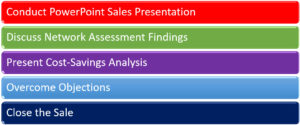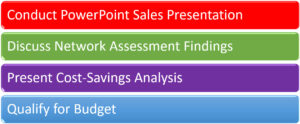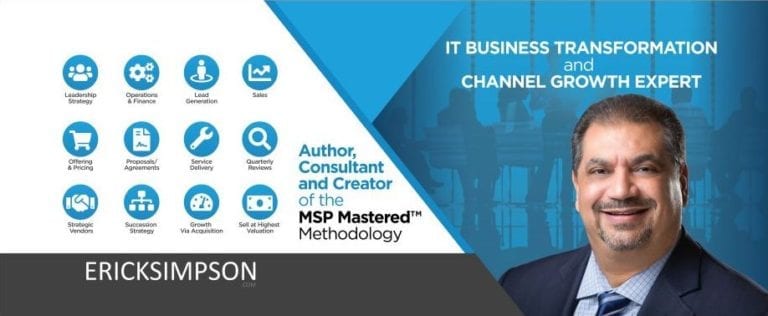Selling Managed Services in 3 Appointments or Less
What are the dynamics of a Managed Services sale?
The dynamics of a Managed Services sale include:
- Building rapport with your prospect
- Conducting a needs analysis
- Gathering data for a cost-savings analysis
- Performing a network assessment
- Delivering a PowerPoint sales presentation to your prospect
- Presenting an infrastructure upgrade proposal when necessary
- Presenting a Managed Services Agreement
- Overcoming objections
- Closing the opportunity
Dynamics of the Sale

The Managed Services Sales Process
A sales process for selling Managed Services can be built around 3 appointments, with the goal being to illustrate to the prospect how the provider can help them use technology to increase profits, decrease costs and mitigate their business pain and risk in a compelling manner so as to close the opportunity.
Although it is possible to sell Managed Services in 2 appointments, the following scenario is built around 3 appointments, with a visit to the prospect’s location between the first and second appointment required in order to conduct a network assessment and gather the information needed to deliver a cost-savings analysis.
The cost-savings analysis is an ROI calculation used to determine what savings the provider can deliver to the prospect by performing vendor management and reducing downtime through proactive remote monitoring and maintenance services.
During the first appointment with a prospect, you’ll conduct a needs analysis to gain an understanding of the prospect’s business, their goals and to determine the prospect’s business pains.
The second appointment is used to deliver a short PowerPoint sales presentation to the prospect and share the findings of the network assessment and cost-savings analysis. This appointment can be utilized to confirm or increase the budget that the prospect can find in order to move forward with your services, as you will now have much more value information to build a sense of urgency and priority in the prospect to address their needs with you.
Once an understanding is reached between you and the prospect in terms of the value of your services, the third appointment is used to overcome any objections and close the prospect on your Managed Services Agreement and Infrastructure Upgrade Proposal, if needed.
The Sales Process

First Appointment Goal
Your goal during the first appointment is to build rapport with the prospect, conduct a needs analysis and determine if there is an opportunity to build a business relationship with the prospect and confirm that the prospect is willing to budget for your services. If the first appointment goes well, you will move forward to the next step – gathering data for the cost-savings analysis and performing a network assessment before the second appointment.
The Goal of the First Appointment

Before the Second Appointment
In order to properly quote the prospect, you will interview key staff in the organization to collect data for the cost-savings analysis and perform a thorough network assessment in order to determine what remediation must occur to the network in order to prepare it for Managed Services delivery.
The Network Assessment
You will schedule a technical resource to scan and thoroughly document the prospect’s network and identify the state of the equipment, its operating systems and installed applications and services. This is critical in order to accurately quote the prospect what it will cost to bring the environment up to a minimum baseline standard for service.
The Cost-Savings Analysis
You will schedule time to interview 3 of the prospect’s staff – the person that deals with all issues involving vendors who service their network, the person that performs “lightweight” IT work and “keeps things running” until they run into a problem that requires them to call in their existing reactive, break-fix I.T. service provider, and the person that handles payroll.
These staff members can tell you how much time they spend dealing with vendor issues, performing internal maintenance to devices on the network, and provide staff salary information – critical data points required to develop the Cost-Savings Analysis, which is the ROI tool you will use to illustrate the value and cost savings your services can deliver to the prospect.

Developing the Cost-Savings Analysis
You will gather the required information in order to complete their ROI analysis. In order to demonstrate the process of calculating potential cost savings for the prospect, the following data will be used as an example:

Cost-Savings Analysis Walk-Through
After gathering the required information, you’ll complete the Cost-Savings Analysis in the following manner:
- Enter the Organization’s Gross Yearly Revenue value of $1,000,000 into the appropriate field on the Cost-Savings Analysis
- Enter the number of Vendors managed by the prospect’s staff into the appropriate field on the Cost-Savings Analysis
- Enter the Number of Hours Spent Managing Vendors Per Month value of 12 into the appropriate field on the Cost-Savings Analysis
- Enter the Vendor Manager’s Hourly Wage value of $45.00 into the appropriate field on the Cost-Savings Analysis
- Enter the Number of Hours Spent Performing IT Functions Per Month value of 12 into the appropriate field on the Cost-Savings Analysis
- Enter the Internal Lightweight IT Staff Member’s Hourly Wage value of $35.00 into the appropriate field on the Cost-Savings Analysis
- Enter the Number of Users in the Environment value of 20 into the appropriate field on the Cost-Savings Analysis
- Enter the Number of Servers in the Environment value of 1 into the appropriate field on the Cost-Savings Analysis
- Enter the Monthly Downtime Hours value of 10 into the appropriate field on the Cost-Savings Analysis
- Enter the Yearly Existing Outsourced I.T. Support Costs value of $10,000 into the appropriate field on the Cost-Savings Analysis
The Cost-Savings Analysis will then calculate the following:

It is now a relatively simple task for you to propose a monthly Managed Services fee to provide Vendor Management, Remote Help Desk and 24×7 Network Monitoring and other maintenance and support services.
Second Appointment Goal
Once you’ve compiled the results of the network assessment and created the Cost-Savings Analysis, you are prepared to visit with the prospect for the second time to discuss these findings and deliver their PowerPoint sales presentation, which highlights the benefits to the prospect of hiring you to deliver Managed Services to their organization, and qualify more specifically for budget.
The Goal of the Second Appointment: Build Maximum Value
Third Appointment Goal
Although closing the prospect may be possible during the second appointment, a third appointment may be required in order to properly present the Infrastructure Upgrade Proposal to bring the prospect’s environment up to a minimum baseline standard for services, and the Managed Services Agreement.
The Goal of the Third Appointment: Close the Sale

Conclusion
A consistent Managed Services sales process based upon value pricing will:
- Portray you as a professional, competent Trusted Advisor looking after the prospect’s bottom line
- Properly lead prospects through a consistent sales experience
- Shorten sales cycles
- Increase the provider’s net profits
- Shorten sales cycles







